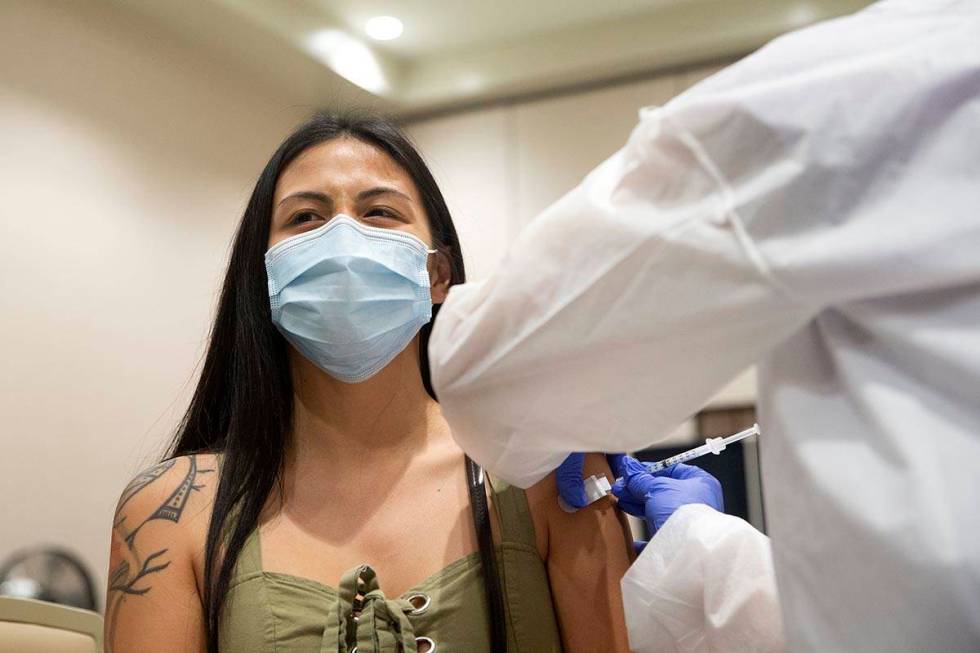COVID cases among vaccinated on the rise in Clark County

Cases of COVID-19 in fully vaccinated people are on the rise, accounting for 15 percent of July’s confirmed cases in Clark County, a Southern Nevada Health District official said Thursday.
This is compared with 2 percent in March and 3 percent in April, ballooning to 12 percent in June, Cassius Lockett, the district’s director of disease surveillance and control, said in an afternoon interview. So far in August, the percentage is 16 percent.
The increase in these breakthrough cases coincides with the delta variant, a far more infectious strain of the coronavirus, gaining a foothold in Southern Nevada, he said.
“This delta variant is truly Godzilla,” Lockett said. “It is truly burning down communities that are unvaccinated and now moving its way into fully vaccinated individuals, as well.”
Since June 1, 11 percent of people hospitalized with COVID-19 had been fully vaccinated, Lockett said. It was not immediately clear what percentage of these COVID-positive people were hospitalized for other conditions, such as heart attack or stroke. In this same time frame, 13 percent of COVID-related deaths were in fully vaccinated people.
Some studies suggest that the delta variant is better than other strains of the virus at evading immunity from vaccination or prior infection. High levels of disease transmission in the community also make it more likely that fully vaccinated individuals will become infected.
Breakthrough cases double
Data requested by the Review-Journal shows that confirmed breakthrough cases in Clark County more than doubled from June 30 to July 30, increasing from 1,282 to 2,609. In most of the cases, the strain of the virus was unknown, though Lockett said that the delta variant represented 90 percent of cases genetically analyzed in the past 30 days.
About 7 percent of confirmed breakthrough cases in Clark County — or 186 — resulted in hospitalization, according to this data. About 1.5 percent, or 40, of all identified breakthrough cases resulted in death.
However, many mild or symptomless infections in individuals who didn’t seek testing go uncounted, which has the effect of increasing percentages of COVID-related hospitalizations and deaths.
As of July 29, 71 percent of hospitalized breakthrough cases were in people 65 and older, and 82 percent had underlying health conditions, such as diabetes, high blood pressure or chronic lung or heart disease, according to data posted by the district on its website.
The health district has continued to track all breakthrough cases through its contact tracing process, asking people who test positive whether they had been vaccinated. It has continued to track the cases even though it is no longer required to do so by the Centers for Disease Control and Prevention, a decision by the federal agency that Lockett believes should be reversed.
If all local health departments report all known breakthrough cases “that’s going to help strengthen our surveillance system, help us learn more a lot faster” about transmission of the virus, he said.
Breakthrough cases should not be used as an excuse not to get vaccinated, health officials say. The vast majority of confirmed cases, hospitalizations and deaths related to COVID-19 are in unvaccinated people. The population in Clark County eligible for vaccination, which is those 12 and older, is almost equally divided between those who are fully vaccinated and those who are unvaccinated.
Gov. Steve Sisolak weighed in on breakthrough cases at his Thursday news conference.
The focus on breakthrough cases “has led to people wondering whether it’s even worth it to get the vaccine,” he said. “The answer is a resounding yes. It’s worth it, because while reports of breakthrough cases may seem increasingly frequent, the vast majority do not end up having severe disease.”
The best protection against the virus remains vaccination, Lockett said.
“If you’re 12 years and older, get vaccinated,” he said. “But meanwhile, masking works and hygiene works, ventilation works.
“We have to use all of these public health strategies to help us get out of this and to prevent the introduction of new variants in the unvaccinated population.
Contact Mary Hynes at mhynes@reviewjournal.com or 702-383-0336. Follow @MaryHynes1 on Twitter. Review-Journal staff writer Michael Scott Davidson contributed to this report.